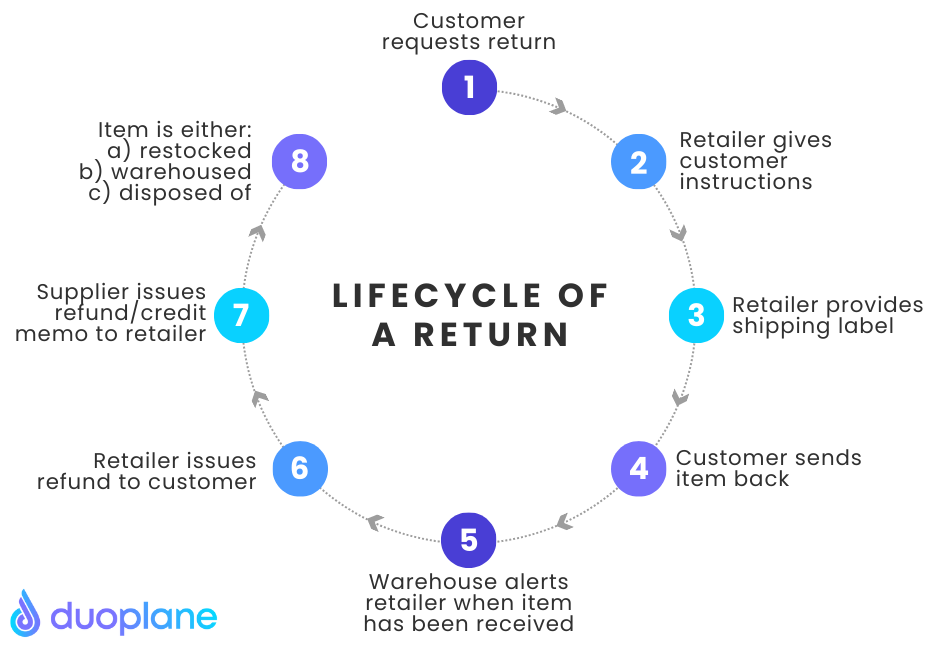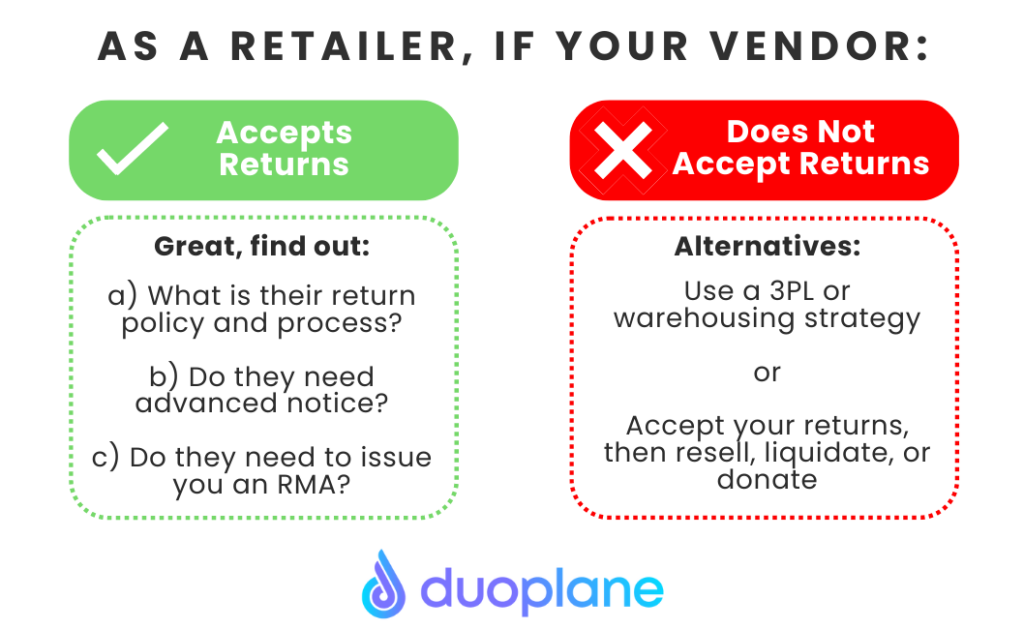July 14th, 2022 | 4 min read

What’s more: Statistics suggest that at least 30% of all products ordered online are returned, while brick-and-mortar stores only see return rates of about 9%.
As a dropship retailer, your goal should be to save time by automating your returns and creating a manageable return process. The first time a customer requests a return should not be the last time they do business with you. After all, 92% of consumers surveyed said they’d be willing to buy from an online store again if the product return process was easy enough.
While dropshipping can be a very efficient business model, it takes some effort to make dropshipping returns easy on the customer as well as your business. Let’s dive into some best practices to manage your returns strategically.
Above all, the most essential part of a business is creating a seamless experience for your end customers. Customers expect a simple, single return policy, so if your vendors have different return policies or returns need to be sent to other places, it is your responsibility as a retailer to alleviate this burden from your customers. As such, having a strong returns experience can significantly boost your brand.
In other words, the fact that you dropshipped an item should not affect the end customer’s experience. The customer views you as the retailer, so they should only communicate and coordinate returns with you.
You may be wondering: what about dropship returns makes them so difficult?
Firstly, different vendors have different policies concerning time frames and conditions of returned goods; while one vendor may allow a 30-day return period, another may only offer a week.
Additionally, tracking is difficult. If one order has items from multiple vendors, they will be split up, and the purchase orders will go to different vendors. This process makes tracking whether packages have been received very challenging. Similarly, tracking your refund from the vendor can be time-consuming.
Furthermore, if one of your vendors does not accept returns, you will be left to deal with the physical inventory. Conversely, if your vendor does take returns, you must ask your customers to send returns back to a different address, which can prove quite confusing.

While it may seem simple, the first step to a strategic approach to returns is outlining the lifecycle of a return:
1) Customer lets the retailer know that they want to return an order and what items are going to be returned
2) Retailer gives the customer instructions on what to do with the return (packing instructions, what to include with the return, how to ship it back).
3) If the retailer is prepaying shipping, the retailer creates a shipping label and provides it to the customer
4) Customer sends the item back
5) Item is received at the returns warehouse/destination
6) Warehouse alerts the retailer that the item has been received
7) After the return is received (or picked up), the retailer issues a refund to the customer
8) If the item was sent back to the original supplier, the supplier issues a refund or credit memo to the retailer
9) Item is either restocked (as new), warehoused separately (as an open box), or disposed of (liquidated or donated)
Duoplane can automate sending POs, inventory syncing, & shipment feeds. Get in touch with us to start your free trial!

Depending on how your vendors handle returns, the strategy you undertake as a retailer will change. Let’s dive into the two most common return scenarios:
If your vendors accept returns, we suggest asking them the following questions:
a) What is their return process?
b) Do they need advanced notice?
c) Do they need to issue you an RMA?
Ideally, your vendor should have a process where retailers can authorize a return. This way, the customer is not waiting for the vendor’s response. Similarly, you will want to standardize processes among your vendors. We suggest aligning your timeline with your vendors’ shortest-duration return policy if you have multiple vendors.
If your vendors do not accept returns, it is your responsibility as a retailer to ensure that returns get handled efficiently with no extra burden placed on the end customer. This can be done in the following ways:
3PL is a third-party logistic distribution channel to outsource elements of your distribution, warehousing, and fulfillment service.
By outsourcing shipping and fulfillment operations, business owners and operations managers alike have been able to cut costs, reduce risk, and more efficiently handle returns. This is because the warehouses inspect and hold your returns for you, effectively eliminating your logistical responsibility.
If you want to learn more about 3PLs and how to implement a 3PL strategy in your business, check out our article here.
When you accept your own returns, you can either resell them as new should their condition be suitable or sell them as an open box. Alternatively, you can keep and store the returns and use a service like Returnly to handle the hassle.

When you accept returns yourself, there are three main ways that you can choose to handle them. Firstly, you can store them in a warehouse and resell them for a discount. Alternatively, you can dispose of them or send them to a liquidator.
This strategy is a very streamlined single-return policy. It does not require any communication between the customer or the vendor, and it allows you, as the retailer, to control your returns.
The downside of this strategy is that you are required to deal with all of the physical inventory. For small businesses with limited returns and adequate storage space, the excess inventory presents little of an issue. However, this extra stock can be overwhelming and hard to maintain for medium-large retailers.
When you send items back to your vendors, you no longer have to deal with logistical battles or hold on to surplus inventory. However, sending them returns can be costly and challenging to coordinate, depending on your vendor’s return policies.
Similarly, if all of your vendors have different return policies, returns can take much longer than anticipated. In turn, this needs to reflect better on your overall customer experience.
If you decide to return items to your vendors, ensure that the return process is aligned between all of your vendors and that you can ensure timely returns.
It is no secret that returns are costly. Instead of sending returns to your vendors or housing unwanted items in a storage closet, many retailers opt to reship the customer a new item without returning the original shipment.
This is an excellent, low-hassle option for low-cost items that are relatively easy to ship or for larger retailers willing to accept the lost revenue.
Unsurprisingly, customers expect a transparent returns policy. Your returns policy should include the following:
If your vendors have different policies, your returns policy should be consistent with the most restrictive of your vendor’s policies. For example, if two of your vendors allow for 30-day return periods, but one only accepts returns within 7 days, you should only offer a 7-day returns policy.
Conversely, if your vendors do not accept returns or have an unfriendly returns policy, you may have to accept returns on your own and create a more kind and lenient policy.
A straightforward returns policy will help your customers start a self-service return and save your support team valuable time.
Return rates typically fall between 10%-20%, so making the experience easy for your customer is an absolute must. Many businesses and customers prefer to use a customer-facing returns portal to speed up the process.
Without an automated returns portal, customers must wait for a customer service reply. Furthermore, returns inquiries take up much support time that could be better used to deal with more complex issues.
In an automated returns portal, customers can start their own reviews. In turn, a returns portal drastically refuses the time and effort that goes into processing reviews and creates a much better customer experience. Some sites that can help you get your returns outlet up and running include Return Magic and Returnly.
When looking for a dropship automation platform that can handle returns, there are a few specific qualities that we recommend looking for:
a) Does the system show expect reviews?
b) Does the system show the status of the items? (i.e., is the item in good condition or defective)
c) Does the system show if the return arrived at the vendor?
d) Does the system allow the vendor to provide a refund or credit for the return?
e) Does the system provide a way to track whether you have received a refund from your vendor?
f) Does the system provide a quick and easy way for you to refund the end customer?
g) Does this system provide a way to send a shipping label to a customer?
We’ve been the industry-leading solution to automate dropshipping operations for over 12 years. Check out our reviews page to learn why our clients love us.

The whole idea behind dropshipping is that it’s a fast, streamlined way to do business. That only works if you have customer returns figured out.
Some upfront work may be required to make your returns more automatic and less painful. But since it’s an integral part of your daily life in eCommerce, it’s worth getting each variable right.
Want to get set up today? Contact Duoplane to see more ways we can help streamline your returns process.
This post was last updated on Jul 28, 2023.
Handling returns in dropshipping involves a clear strategy to ensure customer satisfaction without compromising business efficiency. Key steps include:
Allowing returns in dropshipping is crucial for maintaining customer trust and loyalty. While online purchases inherently have higher return rates due to the lack of physical product inspection, a transparent and efficient return process can enhance customer retention. It’s essential to balance customer expectations with vendor policies, ensuring that the end customer’s experience remains unaffected by the nuances of dropshipping.
A dropshipping return policy should be transparent, consistent, and aligned with vendor policies. It should clearly outline:
Managing refunds in Shopify dropshipping involves verifying the refund request, ensuring its validity, and coordinating with suppliers and vendors. Once verified, the refund can be issued through the Shopify admin. It’s essential to track the refund process, from the customer’s initial request to the supplier’s confirmation, ensuring timely and accurate refunds. Automation tools like Duoplane can help streamline this process, reducing manual oversight.
The responsibility for return costs in dropshipping often depends on the reason for the return and the vendor’s policies. If the return is due to a seller or supplier error, they typically bear the cost. However, if it’s due to a customer’s change of mind, the customer might be responsible. It’s crucial to have a clear understanding with vendors regarding return costs and to communicate this transparently to customers. Using dropship automation platforms can help manage these complexities, ensuring clarity and efficiency in the return process.
Duoplane is a dropshipping automation software built by dropshippers, for dropshippers. We’re here to help you streamline your ecommerce retail fulfillment operations and automate order routing, inventory syncing, shipment feeds, and more.
Don’t just take our word for it – check out our reviews and case studies to learn why we’ve been the industry-leading solution for over 12 years, assisting over 300 retailers in onboarding over 2000 vendors and 3PL warehouses.
Experience the best dropshipping automation software risk-free with our 14-day free trial. Our dedicated onboarding specialists will guide you through the setup process, ensuring you’re ready to hit the ground running.
IF YOU DROP SHIP,
THEN YOU’LL LOVE DUOPLANE.
Duoplane intelligently and automatically routes orders to the right vendor or warehouse.
Keep everyone on the same page and save time by allowing vendors to manage their orders.
Automate vendor inventory feeds to keep your product catalog accurate.
Stay on top of your books by connecting with your accounting system to sync vendor invoices.
Streamline your operations and centralize orders from all of your e-commerce channels
Manage the full order cycle, including changes, shipments, returns, and order exceptions.
Duoplane connects to your existing systems to minimize manual effort by you or your team.
Provide feedback to vendors using actionable performance metrics.
Curious what Duoplane can do? See for yourself with a free trial.
Get in touch with us today!